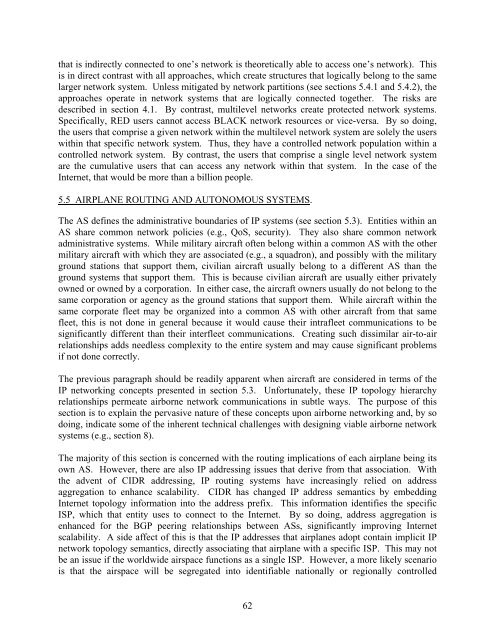Local Area Networks (LANs) in Aircraft - FTP Directory Listing - FAA
Local Area Networks (LANs) in Aircraft - FTP Directory Listing - FAA
Local Area Networks (LANs) in Aircraft - FTP Directory Listing - FAA
You also want an ePaper? Increase the reach of your titles
YUMPU automatically turns print PDFs into web optimized ePapers that Google loves.
that is <strong>in</strong>directly connected to one’s network is theoretically able to access one’s network). This<br />
is <strong>in</strong> direct contrast with all approaches, which create structures that logically belong to the same<br />
larger network system. Unless mitigated by network partitions (see sections 5.4.1 and 5.4.2), the<br />
approaches operate <strong>in</strong> network systems that are logically connected together. The risks are<br />
described <strong>in</strong> section 4.1. By contrast, multilevel networks create protected network systems.<br />
Specifically, RED users cannot access BLACK network resources or vice-versa. By so do<strong>in</strong>g,<br />
the users that comprise a given network with<strong>in</strong> the multilevel network system are solely the users<br />
with<strong>in</strong> that specific network system. Thus, they have a controlled network population with<strong>in</strong> a<br />
controlled network system. By contrast, the users that comprise a s<strong>in</strong>gle level network system<br />
are the cumulative users that can access any network with<strong>in</strong> that system. In the case of the<br />
Internet, that would be more than a billion people.<br />
5.5 AIRPLANE ROUTING AND AUTONOMOUS SYSTEMS.<br />
The AS def<strong>in</strong>es the adm<strong>in</strong>istrative boundaries of IP systems (see section 5.3). Entities with<strong>in</strong> an<br />
AS share common network policies (e.g., QoS, security). They also share common network<br />
adm<strong>in</strong>istrative systems. While military aircraft often belong with<strong>in</strong> a common AS with the other<br />
military aircraft with which they are associated (e.g., a squadron), and possibly with the military<br />
ground stations that support them, civilian aircraft usually belong to a different AS than the<br />
ground systems that support them. This is because civilian aircraft are usually either privately<br />
owned or owned by a corporation. In either case, the aircraft owners usually do not belong to the<br />
same corporation or agency as the ground stations that support them. While aircraft with<strong>in</strong> the<br />
same corporate fleet may be organized <strong>in</strong>to a common AS with other aircraft from that same<br />
fleet, this is not done <strong>in</strong> general because it would cause their <strong>in</strong>trafleet communications to be<br />
significantly different than their <strong>in</strong>terfleet communications. Creat<strong>in</strong>g such dissimilar air-to-air<br />
relationships adds needless complexity to the entire system and may cause significant problems<br />
if not done correctly.<br />
The previous paragraph should be readily apparent when aircraft are considered <strong>in</strong> terms of the<br />
IP network<strong>in</strong>g concepts presented <strong>in</strong> section 5.3. Unfortunately, these IP topology hierarchy<br />
relationships permeate airborne network communications <strong>in</strong> subtle ways. The purpose of this<br />
section is to expla<strong>in</strong> the pervasive nature of these concepts upon airborne network<strong>in</strong>g and, by so<br />
do<strong>in</strong>g, <strong>in</strong>dicate some of the <strong>in</strong>herent technical challenges with design<strong>in</strong>g viable airborne network<br />
systems (e.g., section 8).<br />
The majority of this section is concerned with the rout<strong>in</strong>g implications of each airplane be<strong>in</strong>g its<br />
own AS. However, there are also IP address<strong>in</strong>g issues that derive from that association. With<br />
the advent of CIDR address<strong>in</strong>g, IP rout<strong>in</strong>g systems have <strong>in</strong>creas<strong>in</strong>gly relied on address<br />
aggregation to enhance scalability. CIDR has changed IP address semantics by embedd<strong>in</strong>g<br />
Internet topology <strong>in</strong>formation <strong>in</strong>to the address prefix. This <strong>in</strong>formation identifies the specific<br />
ISP, which that entity uses to connect to the Internet. By so do<strong>in</strong>g, address aggregation is<br />
enhanced for the BGP peer<strong>in</strong>g relationships between ASs, significantly improv<strong>in</strong>g Internet<br />
scalability. A side affect of this is that the IP addresses that airplanes adopt conta<strong>in</strong> implicit IP<br />
network topology semantics, directly associat<strong>in</strong>g that airplane with a specific ISP. This may not<br />
be an issue if the worldwide airspace functions as a s<strong>in</strong>gle ISP. However, a more likely scenario<br />
is that the airspace will be segregated <strong>in</strong>to identifiable nationally or regionally controlled<br />
62
















